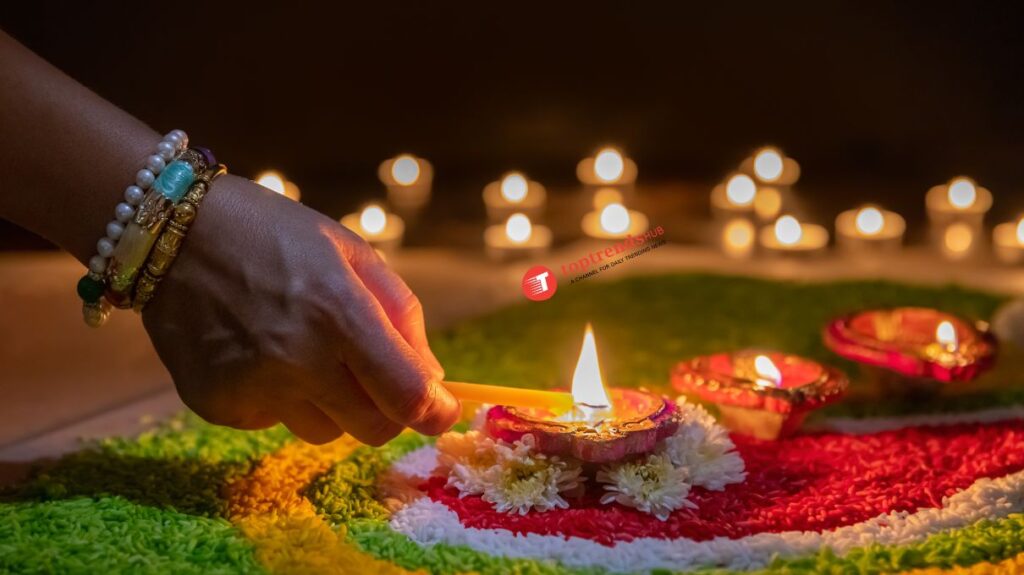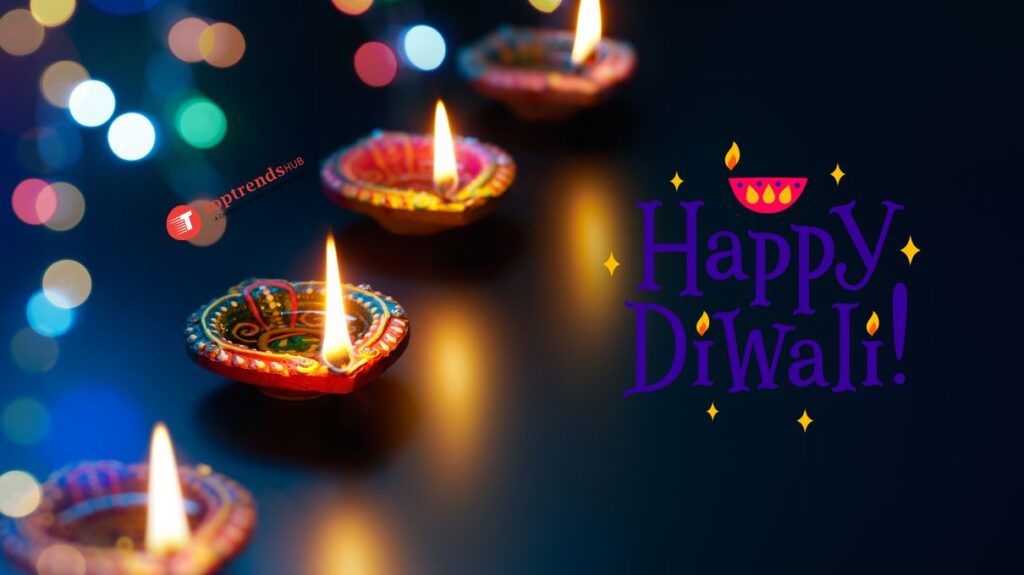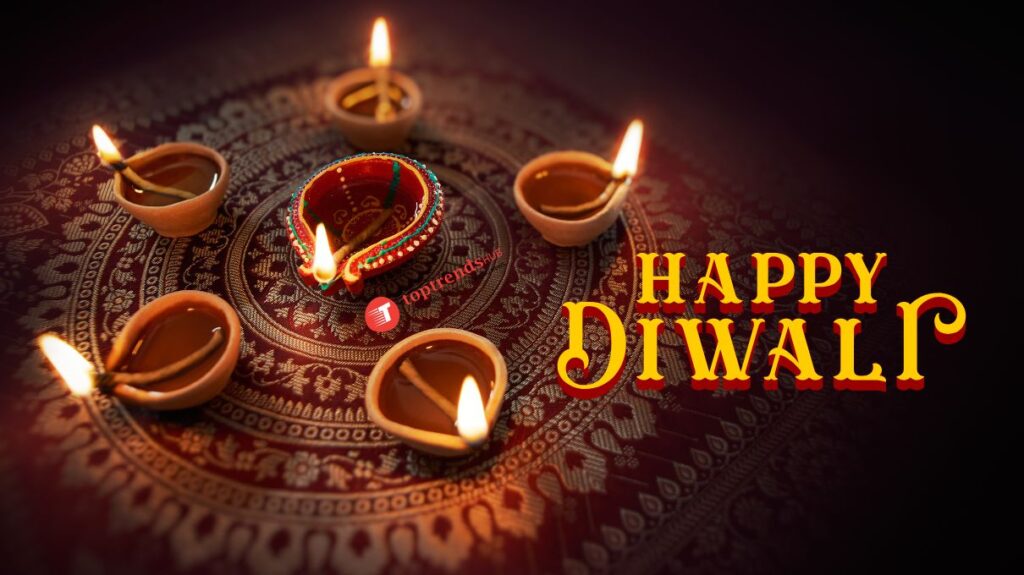Diwali 2024, the Festival of Lights, is one of the most significant Hindu festivals celebrated across India and by Hindus worldwide. The 2024 Diwali calendar outlines the five days of rituals, each with its own special meaning and religious importance. The festivities extend beyond just the primary day of Diwali, offering a blend of rituals that celebrate wealth, light, relationships, and life itself. Here’s an in-depth look at the Diwali 2024 calendar and the traditions behind each day of celebration.
Diwali 2024 Date and Shubh Muhurat
This year, Diwali falls on October 31, 2024. According to the Hindu lunar calendar, Diwali is observed on the 15th day of Kartik, the darkest night of the month. On this auspicious occasion, homes are adorned with diyas (oil lamps), vibrant rangoli patterns, and shimmering lights. It’s a time of joy, unity, and spiritual reflection.


Diwali 2024 Calendar: Detailed Guide to the 5 Days of Celebration (toptrendshub.com)
Here is the important Shubh Muhurat (auspicious timings) for Lakshmi Puja and other key events
| Events | Shubh Muhurat |
| Lakshmi Puja | 6:52 PM to 8:41 PM |
| Pradosh Kaal | 6:10 PM to 8:52 PM |
| Vrishabha Kaal | 6:52 PM to 8:41 PM |
| Amavasya Tithi Begins | 6:22 AM on October 31, 2024 |
| Amavasya Tithi Ends | 8:46 AM on November 1, 2024 |
Diwali 2024 Date and Shubh Muhurat
Diwali 2024, or Deepawali, stands as the most anticipated Hindu festival, celebrated with immense joy and grandeur. In 2024, Diwali occurs on October 31, the 15th day of the Kartik month according to the Hindu lunar calendar. This night, known as Amavasya (new moon), is considered the darkest of the year. The festival signifies light’s triumph over darkness and good’s victory over evil. Homes and streets glow with a bright array of lights and Diya’s, enhancing the festive atmosphere.
People eagerly await the Shubh Muhurat to perform religious rituals, especially during Lakshmi Puja, the worship of Goddess Lakshmi. Hindus revere her as the goddess of wealth, prosperity, and happiness, making her puja the central focus of Diwali 2024 celebrations. As the day progresses, families prepare elaborate altars adorned with images or idols of Goddess Lakshmi and Lord Ganesha to remove obstacles.
This year, the most auspicious Shubh Muhurat timings for Lakshmi Puja are:
- Lakshmi Puja Muhurat: 6:52 PM to 8:41 PM
- Pradosh Kaal: 6:10 PM to 8:52 PM
- Vrishabha Kaal: 6:52 PM to 8:41 PM
- Amavasya Tithi Begins: 6:22 AM on October 31, 2024
- Amavasya Tithi Ends: 8:46 AM on November 1, 2024
The Pradosh Kaal, which immediately follows sunset, is the ideal time for the Lakshmi Puja. Families light up their homes, making them inviting for Goddess Lakshmi, who is believed to visit homes that are clean and brightly lit. As diyas and candles illuminate every corner, families chant prayers, offering sweets, fruits, and incense to the deities.
Alongside religious rituals, families come together for celebrations, creating a warm and joyful atmosphere. Many people also opt for eco-friendly alternatives, like clay diyas, natural rangoli colors, and quieter fireworks, ensuring a more environmentally conscious celebration.

Day 1: Dhanteras (October 29, 2024)
The five-day Diwali 2024 festivities kick off with Dhanteras on October 29, 2024. The word Dhanteras” combines two significant Sanskrit words: “Dhan,” meaning wealth, and “Teras, which refers to the 13th day of Krishna Paksha in the Kartik month. This day holds great importance because people worship Goddess Lakshmi, the goddess of wealth, and Lord Kuber, the treasurer of the gods, to seek prosperity.
People flock to markets and shops to purchase precious items such as gold, silver, or new household goods. These items symbolize wealth and bringing them into the home on Dhanteras is believed to attract prosperity. Throughout the day, families clean their homes, decorate them with beautiful rangolis, and prepare for the evening’s Lakshmi and Kuber Puja.
As evening approaches, devotees set up sacred altars with idols or images of Lakshmi and Kuber. Flowers, sweets, and incense enhance the offerings, and families chant prayers, seeking the blessings of wealth and abundance. Lighting 13 diyas across the home signifies protection against negative energies and invites positive influences into the household.
Another key aspect of Dhanteras involves focusing on health and well-being. Dhanvantari Jayanti also falls on this day, celebrating the birth of Dhanvantari, the god of Ayurveda. People pray for good health and longevity, recognizing the importance of well-being in their lives. Families then gather for special meals, enjoying festive dishes like besan ladoo, kheer, and puri.
The transition from Dhanteras to the next day signifies a shift in focus, from wealth to overcoming evil forces, preparing everyone for the upcoming Naraka Chaturdashi.

Day 2: Naraka Chaturdashi (Choti Diwali) (October 31, 2024)
The second day of the Diwali 2024 celebrations, Naraka Chaturdashi, also known as Choti Diwali, takes place on October 31, 2024. This day celebrates the victory of Lord Krishna over the demon Narakasura, symbolizing good’s triumph over evil. As the legend of Narakasura unfolds, it emphasizes how bravery and righteousness always conquer darkness and malevolence.
People begin the day early, performing the Abhyang Snan ritual, a bath with scented oils that symbolizes purification. This bath holds both physical and spiritual importance, as it removes negative energies and brings peace and protection. Families believe that taking this bath before sunrise ensures long life and protection from evil.
After the bath, people decorate their homes with diyas, candles, and lights, focusing on dispelling darkness in both literal and figurative senses. Homes glow with light, symbolizing the removal of ignorance and the welcoming of wisdom. Special sweets like chakli, ladoos, and karanji are prepared, and families exchange them with friends and neighbors.
In some regions, especially in Bengal, people worship Goddess Kali on this day, adding a layer of spiritual significance to the celebrations. Despite being a smaller festival compared to the main Diwali 2024 day, Choti Diwali is crucial as it honors the spirit of hope and courage.
As evening falls, families light fireworks to drive away negative energies and celebrate the arrival of light. More people are now shifting to eco-friendly alternatives like quieter fireworks and natural decorations, making the celebrations more sustainable while maintaining the festive spirit.

Day 3: Diwali and Lakshmi Puja (October 31, 2024)
The third day, Diwali 2024, is the pinnacle of the five-day festival. In 2024, it also falls on October 31, sharing the date with Naraka Chaturdashi. As the Festival of Lights, Diwali signifies light’s ultimate victory over darkness. People celebrate with incredible enthusiasm, illuminating homes and streets with rows of oil lamps, candles, and twinkling lights.
During the evening, Lakshmi Puja takes center stage. Families worship Goddess Lakshmi, seeking blessings of wealth, prosperity, and happiness. The Pradosh Kaal, the time immediately after sunset, is considered the most auspicious time for the puja. People ensure their homes are clean and beautifully decorated with rangolis to welcome the goddess.
The puja begins with placing idols or images of Goddess Lakshmi and Lord Ganesha on a well-decorated altar. Offerings of flowers, sweets, and fruits create a sacred ambiance, while families chant prayers and perform a Lakshmi Aarti, a traditional song of praise for the goddess. This ritual expresses gratitude and invokes blessings for prosperity.
After the puja, families exchange gifts, signifying love and appreciation. Sweets like kaju katli, gulab jamun, and laddoos are distributed among family, friends, and neighbors, further enriching the joyous spirit of Diwali.
As the night progresses, fireworks illuminate the sky, adding to the excitement and festivities. Yet, many are now choosing eco-friendly ways to celebrate Diwali 2024, reducing the use of noisy fireworks and opting for quieter, safer alternatives.
Ultimately, Diwali 2024 represents a time of reflection and renewal. It urges individuals to cleanse their hearts and homes, embrace positivity, and light the way forward.
Day 4: Govardhan Puja (November 2, 2024)
Govardhan Puja, celebrated on November 2, 2024, marks the fourth day of Diwali 2024. This festival honors Lord Krishna and his divine act of lifting the Govardhan Hill to protect the people of Gokul from a devastating storm. Krishna’s message during this event emphasizes the importance of respecting nature and acknowledging its role in sustaining life.
On this day, families worship Govardhan Hill by creating small replicas of the hill using cow dung or mud, symbolizing Krishna’s protection of his devotees. Devotees also feed cows, which are sacred in Hinduism, and offer prayers to Lord Krishna, recognizing his role in preserving life.
Additionally, the day revolves around Annakut, a feast that involves offering a variety of vegetarian dishes to Lord Krishna. This Annakut offering symbolizes gratitude for nature’s bounty. People prepare a grand meal with various delicacies such as rice, curries, sweets, and breads, which they first offer to Krishna and then distribute among the community.

As the day progresses, communities come together to celebrate through singing, dancing, and other cultural activities. In places like Vrindavan and Mathura, the festivities include grand processions and reenactments of Krishna’s lifting of Govardhan Hill.
The message of Govardhan Puja resonates today, reminding everyone to live sustainably and respect the environment. The importance of being grateful for nature’s gifts is just as relevant as it was in Krishna’s time.
Day 5: Bhai Dooj (November 3, 2024)
The final day of the Diwali celebration, Bhai Dooj, falls on November 3, 2024. This day strengthens the bond between brothers and sisters, focusing on love, protection, and blessings. Unlike Raksha Bandhan, Bhai Dooj involves sisters applying a tilak on their brothers’ foreheads and praying for their longevity and well-being.
The story behind Bhai Dooj comes from the bond between Yama, the god of death, and his sister Yamuna. On this day, Yamuna welcomed Yama to her home, performed a tilak ceremony, and prayed for his long life. In return, Yama granted her a boon, ensuring that any brother who receives a tilak from his sister would enjoy a long and prosperous life.
The day begins with sisters inviting their brothers home. They perform a tilak ceremony, apply rice and vermillion on their brothers’ foreheads, and then perform an aarti to protect them from evil. Brothers reciprocate by giving their sisters gifts, strengthening the love and respect they share.
Families prepare special dishes like kheer, puran poli, and malpua, which add to the festive atmosphere. Bhai Dooj also provides an opportunity for families to come together and enjoy each other’s company.
Even in today’s world, where families may live far apart, Bhai Dooj remains a meaningful occasion. Siblings use technology to celebrate virtually, maintaining the essence of the tradition by exchanging gifts and blessings, even across distances.

Bhai Dooj, with its emphasis on familial love and protection, concludes the Diwali festival on a heartwarming note. It reaffirms the value of relationships, making it a fitting end to the five-day celebration.




